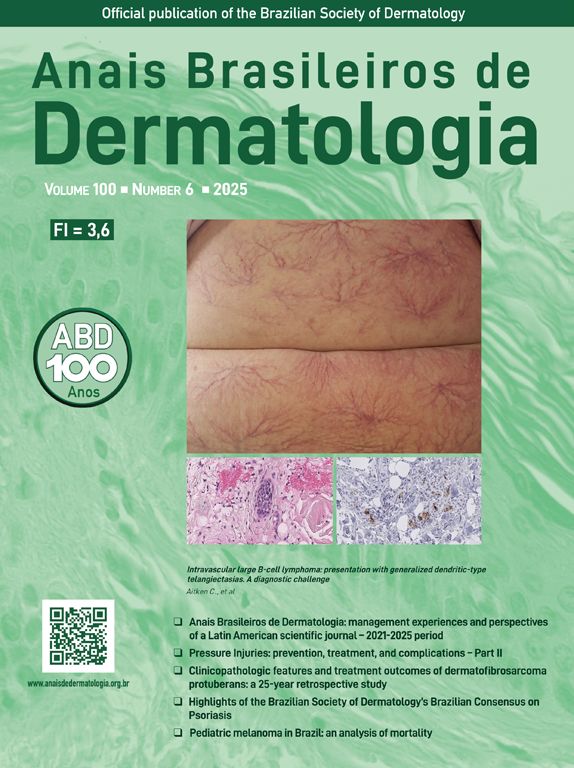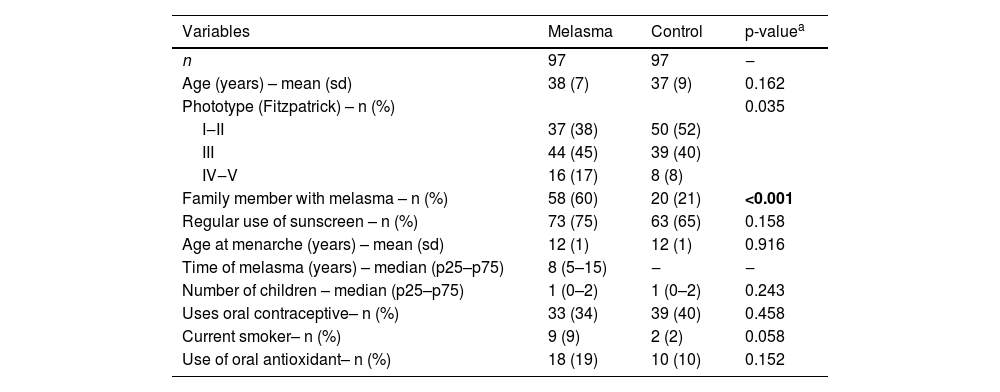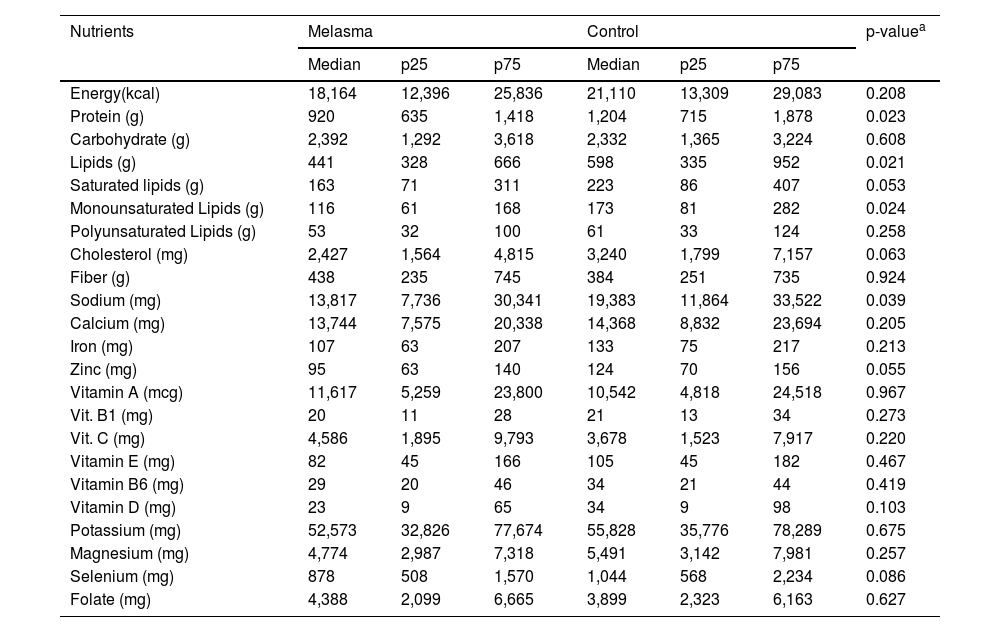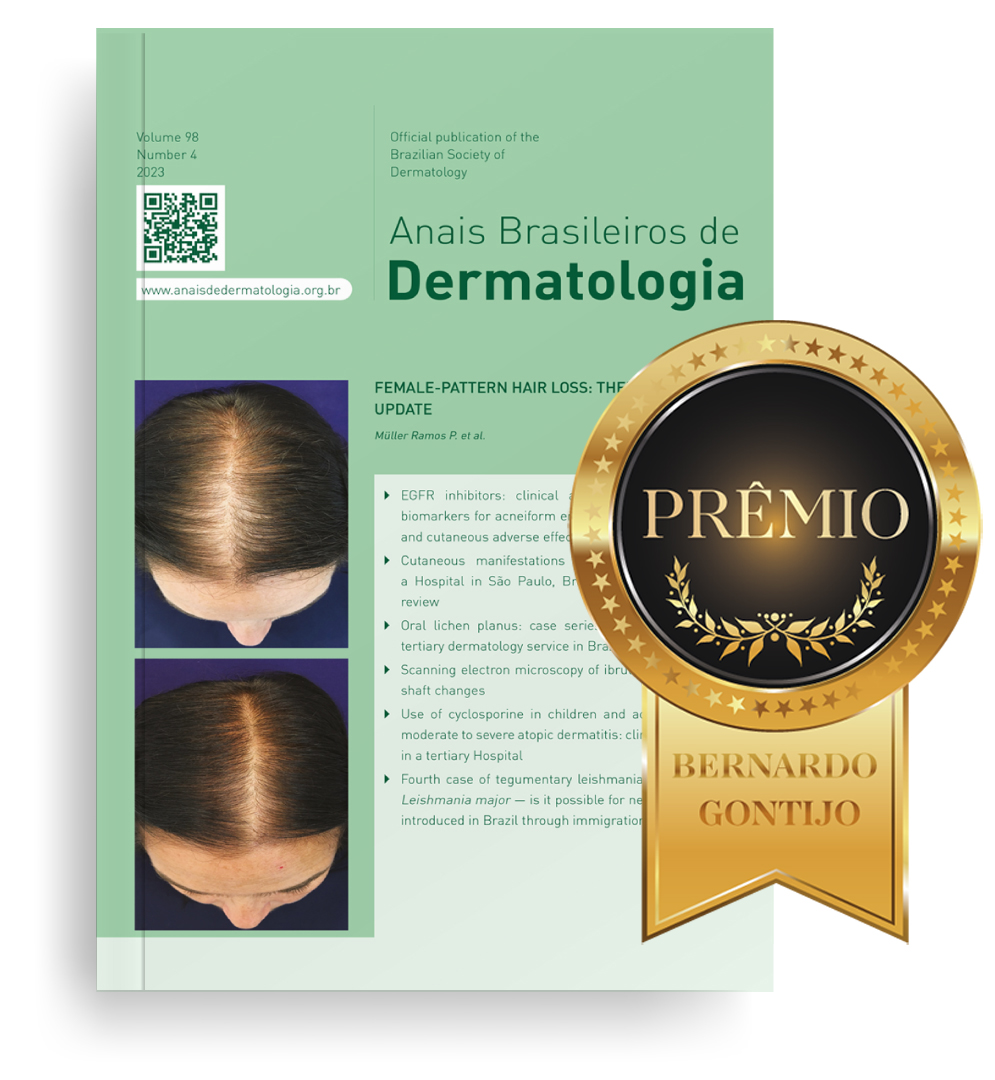Melasma is a chronic, multifactorial pigmentary dermatosis that exclusively affects sun-exposed areas (with lesions predominantly on the face) and is more prevalent in women in the period between menarche and menopause. Genetic predisposition, exposure to ultraviolet radiation (UVR), and hormonal stimuli are its main triggers. However, other factors, such as exposure to environmental pollution, heat, sleep deprivation, and chronic conditions such as depression, can aggravate systemic oxidative stress, potentially contributing to the genesis and progression of melasma.1
Systemic oxidative stress is prominent in patients with melasma. Concurrently, the administration of oral antioxidants, such as pycnogenol, enhances the clearing effect of topical treatment.2
Chronic exposure to UVR, especially type A, induces both cell and systemic oxidative stress, contributing to the sustained melanogenesis observed in melasma.1 There is a negative correlation between the clinical severity of melasma and plasma glutathione (GSH) levels, as well as increased levels of components of the intracellular antioxidant defense enzyme system, such as superoxide dismutase (SOD) and GSH-peroxidase.3 Furthermore, individuals with melasma have higher plasma concentrations of malondialdehyde, a byproduct of lipid peroxidation that is a marker of cell damage.4
In the context of antioxidant defense mechanisms, in addition to the enzyme system (such as SOD and GSH-peroxidase), the importance of non-enzymatic antioxidants obtained through diet stands out. These include compounds present in foods rich in beta-carotene, vitamins C and E, ellagic acid, bioflavonoids, catechins, isoflavones, lycopene, omega-3 fatty acids, polyphenols, resveratrol, selenium, zinc, and cysteine.
To date, no study has systematically evaluated dietary aspects in individuals with melasma. To fill this gap, a cross-sectional study was conducted to investigate dietary patterns, with a specific focus on the intake of antioxidant-rich foods, in women with facial melasma compared to those without the condition.
After approval by the institutional ethics committee (CAAE 26390419.7.0000.5515), 194 adult women of childbearing age (aged 18 to 49) were included and divided into two groups: 97 with facial melasma (diagnosed by a dermatologist) and 97 controls. Participant recruitment occurred from September 2023 to January 2024. Matching was performed by age, and women with concomitant facial dermatoses were excluded. Sampling was consecutive, among patients treated at the Presidente Prudente Regional Hospital, and was conducted after informed consent was obtained.
The main study outcome measure was the adapted Food Frequency Questionnaire (FFQ), which was administered to participants to assess their weekly consumption of 41 types of foods (Supplementary Material). The data obtained were converted to grams, and from this, energy, macronutrient, and micronutrient values were calculated using the Nutritional Data System for Research (NDSR) software. Dietary patterns were analyzed based on their components, extracted using the PLS (Partial Least Squares) method, using data scaled by standard deviations.5 All dietary intake assessments were processed and analyzed by a nutritionist (TCF).
In addition, demographic data, adherence to photoprotection, smoking status, and oral antioxidant supplementation were collected. Nutrients were compared between groups using the Mann-Whitney (exact) test, with significance set at p ≤ 0.01. Sample size was calculated to detect a minimum difference of 20% in nutrient intake between groups, with an alpha of 0.01 and a beta of 0.1.
There were no differences between the groups in age, phototypes, age at menarche, smoking status, number of children, adherence to sunscreen, contraceptive use, or oral antioxidant supplementation (Table 1).
Main demographic data of women with melasma and controls.
| Variables | Melasma | Control | p-valuea |
|---|---|---|---|
| n | 97 | 97 | ‒ |
| Age (years) – mean (sd) | 38 (7) | 37 (9) | 0.162 |
| Phototype (Fitzpatrick) – n (%) | 0.035 | ||
| I‒II | 37 (38) | 50 (52) | |
| III | 44 (45) | 39 (40) | |
| IV‒V | 16 (17) | 8 (8) | |
| Family member with melasma – n (%) | 58 (60) | 20 (21) | <0.001 |
| Regular use of sunscreen – n (%) | 73 (75) | 63 (65) | 0.158 |
| Age at menarche (years) – mean (sd) | 12 (1) | 12 (1) | 0.916 |
| Time of melasma (years) – median (p25–p75) | 8 (5–15) | ‒ | ‒ |
| Number of children – median (p25–p75) | 1 (0–2) | 1 (0–2) | 0.243 |
| Uses oral contraceptive– n (%) | 33 (34) | 39 (40) | 0.458 |
| Current smoker– n (%) | 9 (9) | 2 (2) | 0.058 |
| Use of oral antioxidant– n (%) | 18 (19) | 10 (10) | 0.152 |
The diet in both groups was monotonous, and the most commonly consumed foods per week in both groups were milk, cheese, oranges, tomatoes, coffee, and white meat. No celiac disease or vegetarians were found in the sample. Extraction of three PLS components based on the dietary patterns formed by the 41 foods studied explained the variance of only 20% of the groups, without implying adequate separation between the melasma group and controls (Fig. 1). Furthermore, no differences were observed between the two groups regarding the consumption of macro and micronutrients, including dietary antioxidants (Table 2).
Nutritional data of participants' diets, reported in one week (n = 194).
| Nutrients | Melasma | Control | p-valuea | ||||
|---|---|---|---|---|---|---|---|
| Median | p25 | p75 | Median | p25 | p75 | ||
| Energy(kcal) | 18,164 | 12,396 | 25,836 | 21,110 | 13,309 | 29,083 | 0.208 |
| Protein (g) | 920 | 635 | 1,418 | 1,204 | 715 | 1,878 | 0.023 |
| Carbohydrate (g) | 2,392 | 1,292 | 3,618 | 2,332 | 1,365 | 3,224 | 0.608 |
| Lipids (g) | 441 | 328 | 666 | 598 | 335 | 952 | 0.021 |
| Saturated lipids (g) | 163 | 71 | 311 | 223 | 86 | 407 | 0.053 |
| Monounsaturated Lipids (g) | 116 | 61 | 168 | 173 | 81 | 282 | 0.024 |
| Polyunsaturated Lipids (g) | 53 | 32 | 100 | 61 | 33 | 124 | 0.258 |
| Cholesterol (mg) | 2,427 | 1,564 | 4,815 | 3,240 | 1,799 | 7,157 | 0.063 |
| Fiber (g) | 438 | 235 | 745 | 384 | 251 | 735 | 0.924 |
| Sodium (mg) | 13,817 | 7,736 | 30,341 | 19,383 | 11,864 | 33,522 | 0.039 |
| Calcium (mg) | 13,744 | 7,575 | 20,338 | 14,368 | 8,832 | 23,694 | 0.205 |
| Iron (mg) | 107 | 63 | 207 | 133 | 75 | 217 | 0.213 |
| Zinc (mg) | 95 | 63 | 140 | 124 | 70 | 156 | 0.055 |
| Vitamin A (mcg) | 11,617 | 5,259 | 23,800 | 10,542 | 4,818 | 24,518 | 0.967 |
| Vit. B1 (mg) | 20 | 11 | 28 | 21 | 13 | 34 | 0.273 |
| Vit. C (mg) | 4,586 | 1,895 | 9,793 | 3,678 | 1,523 | 7,917 | 0.220 |
| Vitamin E (mg) | 82 | 45 | 166 | 105 | 45 | 182 | 0.467 |
| Vitamin B6 (mg) | 29 | 20 | 46 | 34 | 21 | 44 | 0.419 |
| Vitamin D (mg) | 23 | 9 | 65 | 34 | 9 | 98 | 0.103 |
| Potassium (mg) | 52,573 | 32,826 | 77,674 | 55,828 | 35,776 | 78,289 | 0.675 |
| Magnesium (mg) | 4,774 | 2,987 | 7,318 | 5,491 | 3,142 | 7,981 | 0.257 |
| Selenium (mg) | 878 | 508 | 1,570 | 1,044 | 568 | 2,234 | 0.086 |
| Folate (mg) | 4,388 | 2,099 | 6,665 | 3,899 | 2,323 | 6,163 | 0.627 |
Despite the oxidative microenvironment in the upper dermis, the causes of systemic oxidative imbalance in melasma patients are not understood, and the results of this study demonstrated no differences in dietary antioxidant consumption in these patients.
The eating habits of the urban Brazilian population are unbalanced, characterized by low food variability, high caloric intake of carbohydrates such as rice and pasta, and consumption of ultraprocessed foods, but low intake of fiber and micronutrients.6 The study participants did not exhibit eating habits that differed from those of the urban Brazilian population.
Research on dietary patterns and their association with health outcomes is important but has been little explored systematically in the dermatological literature. It is also important to highlight that understanding the nutritional components of a diet influences not only the body's nutritional aspects but also the composition of the intestinal microbiome, the effects of xenobiotics, and the overall epigenetic control exerted by certain foods.7
There are no robust studies in the literature that have investigated the increased consumption of antioxidant-rich foods in other dermatoses. Specifically in rosacea, studies with zinc supplementation have shown conflicting results and methodological limitations, resulting in insufficient evidence to recommend its clinical use. A review of the literature on dietary supplements showed that, in patients with vitiligo, only oral vitamin D replacement is recommended in cases of proven deficiency, although there is still no consensus on the ideal dose to promote repigmentation. The use of Polypodium leucotomos is also indicated, as long as it is combined with phototherapy, and shows evidence of increased repigmentation, especially in exposed areas. Supplementation with vitamins C and B12, vitamin E, antioxidant mixtures, and Ginkgo biloba still has insufficient evidence for routine recommendation.8
A Chinese study involving 150 cases and 150 controls identified alcohol intake as a risk factor (Odds Ratio = 20.5) and soft drink consumption as a protective factor (Odds Ratio = 0.04) for the development of melasma. However, these factors have not been adequately investigated from a pathophysiological perspective.9 And, despite being a common demand of patients, there are still no validated associations between dietary aspects and the onset of melasma. In this study, no differences in dietary patterns were identified when comparing women with melasma and the control group.
To date, evidence suggests oral supplementation with antioxidants (such as pycnogenol) as an adjunct to treatment.10 In the context of specific dietary intake, it is hypothesized that soy may exacerbate melasma due to its "estrogen-like" action; however, there is no data on a critical amount for this outcome.11
Studies related to dietary patterns have limitations related to participant recall, food recall, and the monotony of urban populations' diets. However, sample homogeneity, such as that of these participants from a single center, strengthens internal validity when exploring factors linked solely to diet. The lack of observational association does not mean that dietary interventions are ineffective; however, different study designs are required to confirm this. Finally, studies exploring the intestinal microbiome may suggest dietary interventions for melasma.
In conclusion, neither dietary patterns nor dietary antioxidant consumption is associated with the development of melasma in Brazilian women.
Authors' contributionsAna Cláudia Cavalcante Espósito: Design and planning of the study; analysis and interpretation of data; drafting and editing of the manuscript; critical review of the literature; critical review of the manuscript; approval of the final version of the manuscript.
Carla Rakoski Ribas: Design and planning of the study; analysis and interpretation of data; drafting and editing of the manuscript; critical review of the literature; critical review of the manuscript; approval of the final version of the manuscript.
Gracielli Ferreira Barbosa: Design and planning of the study; analysis and interpretation of data; drafting and editing of the manuscript; critical review of the literature; critical review of the manuscript; approval of the final version of the manuscript.
Julia Dias Bendini: Design and planning of the study; analysis and interpretation of data; drafting and editing of the manuscript; critical review of the literature; critical review of the manuscript; approval of the final version of the manuscript.
Rita Gisele Biffi Medeiros: Design and planning of the study; analysis and interpretation of data; drafting and editing of the manuscript; critical review of the literature; critical review of the manuscript; approval of the final version of the manuscript.
Carolina Nunhez da Silva: Design and planning of the study; analysis and interpretation of data; drafting and editing of the manuscript; critical review of the literature; critical review of the manuscript; approval of the final version of the manuscript.
Tatiana Cristina Figueira: Analysis and interpretation of data; drafting and editing of the manuscript; collection of data; approval of the final version of the manuscript.
Hélio Amante Miot: Design and planning of the study; analysis and interpretation of data; statistical analysis; drafting and editing of the manuscript; critical review of the literature; critical review of the manuscript; approval of the final version of the manuscript.
Approval by the Ethics CommitteeThis project was approved by the Ethics Committee of Universidade do Oeste Paulista CAAE: 26390419.7.0000.5515 (UNOESTE).
Financial supportNone declared.
Availability of research dataThe entire dataset supporting the results of this study was published in this article.
None declared.
Study conducted at the Hospital Regional de Presidente Prudente Doutor Domingos Leonardo Cerávolo, Presidente Prudente, SP, Brazil







